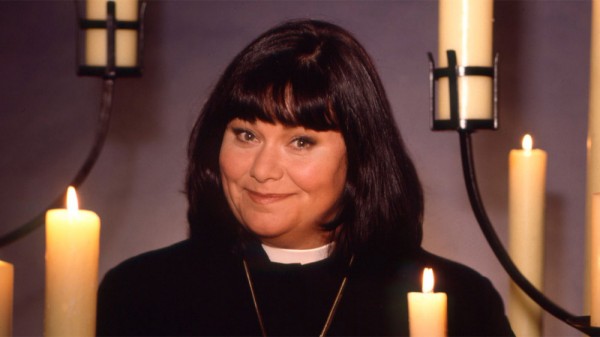Can it really be twenty years since The Vicar of Dibley first appeared on our screens? No no no no no no – yes!
Yes, it can, with the first episode having aired in November 1994. Not perhaps the most prolific of shows (20 years on, we’ve only had 20 episodes, the last in 2007) and yet in some inexplicable way it’s a programme that has slipped into our affections in a way many other shows would envy.
On the one hand, Dibley is a broad brush, grotesque comic invention, an absurd view of a quiet English village where the residents are scatter-brained, inbred morons; people who in the real world we would cross the street to avoid (or indeed, move to an entirely different street altogether). But at the same time, there’s a fundamental goodness and even a ‘reality’ to the people of Dibley which makes them oddly enduring, and which in turn means that we not only warm to them, we really care about them.
It’s hardly the first comedy show to have a vein of ‘genuine’ emotion running through it – Steptoe & Son did it, Only Fools and Horses did it, even the occasional Dad’s Army and the very last It Ain’t Half Hot Mum did it. But I think where Dibley differs is in its situation.
All those other shows are set in a ‘real’ world, albeit one heightened or exaggerated for comic effect. Dibley, with its sex-mad parish council, its tacit acknowledgement of bestiality, and its ‘Village of the Damned Stupid’ scenario, is not trying to be an Ambridge or an Emmerdale, it’s not trying to be a ‘real’ environment at all.
So it’s expecting a huge leap by the audience to then care about the characters as if they are real – or maybe it’s not. Maybe the audience is always prepared to leap when there are some good laughs, and some great performances, and when, to get down to it, it is such a fun programme. Then to suddenly turn on a sixpence and make us sad or cry or think, maybe it’s not such a difficult thing after all – maybe it’s just having the nerve, and the expertise, and the scripts and the cast to do it.

The show itself seems to be aware of its own dual personality, as early as its seventh episode, the Easter Special aired in 1996. Mrs Cropley spends the first season regaling us with various tales of her past (Dibley’s disappointing, but totally realistic, Lady Godiva being just one such anecdote) as well as concocting some of the most hideous culinary combinations known to man – Marmite cake, tripe salad, peanut butter and anchovy sandwiches…
Then suddenly she’s taken ill and the Vicar is called to her bedside; and as she goes, the Vicar reassures verger Alice that Mrs Cropley will be fine because: “[Dibley] is a happy valley, nobody dies here.”
Five minutes later, of course, Mrs Cropley has passed away (Liz Smith sadly leaving the party early just as it’s really starting to get going) and the gathered friends are in mourning. And from then on, huge slapstick nonsense such as the famous puddle scene rubs shoulders with some genuine emotions, from Frank’s coming out to Alice’s ultrasound pictures to David’s plea for the Vicar to “stay”.
But before this celebration of twenty years of Dibley has you looking to open a vein, let’s celebrate the people we’ve come to know and love – and you’ll see that, here too, there aren’t just laughs but tears as well. On the face of it, an everyday story of simple, simple, simple country folk; but beneath the surface, much, much more than that.
Bless you.
> Buy the Ultimate Collection boxset on Amazon.
What’s your favourite moment in The Vicar of Dibley? Let us know below…

